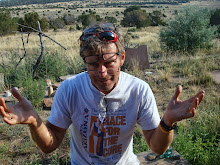He looks the part -- beat-up wide brimmed hat (prison orange), lanky gait, wry smile. And when he talks, stories about Yuma ranches and desert animals come pouring out.
My first take on him was that the stories were corny old re-runs of cowboy lore, but as he kept talking, they took on the sheen of freshly lived experience. I realized this guy was the real deal, that Cowboy had been living in some back water time capsule of horses, cattle, mules, dusty work, and long stretches between visits to town. His writing was about as unaffected as any I have read. It was just the facts, told with an unvarnished voice.
There was style, living pathos, and charm in the stories about favorite dogs, donkeys, and Yuma history.
I thought he should submit some of his work to Arizona Highways or other glossies that eat up the old and nostalgic West. But that cost money for postage, and Cowboy was indigent as well as untutored in query letters. If he ever sent any out I never heard that he got a response.
His was a world in stark contrast to the urban blight in the background of most of the other members of the workshop. Where they looked for a shocking detail, an edge that might cut into a reader's complacence, Cowboy lulled his audience into sleepy world where trains still ran, outlaws had an anti hero stardom, and pick-up trucks were less common than horses.
The editors decided to publish a few of his pieces, the first he ever published. Cowboy was pleased, but that's about it. It was no big deal, but he did want us to send a copy of the magazine to family. The last piece he wrote in the workshop boded well for the stories to come.
Color of Money
In
1984 I was driving a cattle truck. I had
loaded 45 head of fat cattle at John Wayne’s Red River Ranch down at Stanfield,
AZ. I was headed west to a packing house
in East Los Angeles, traveling on I-10 through Indio, CA, running 20 miles over
the speed limit. I was pulled over by
the CHP. I was watching the officer out
of my mirror as he was walking up to the cab.
He stopped alongside the trailer and he put his head up close to one of
the observation holes just as a steer was taking a shit. Well, you can guess what happened. Cop gets up to my cab and looks up at me, and
he is covered in shit from his fancy trooper hat down to his silver buckle.
He says, “Driver, I’ve been on the
force 20 years, and I have taken a lot of shit.
But this is the first time I ever ate it. Driver, get your ass down the road and you
better say nothing.”
He’s looking straight at me as I say,
“Yes, sir.”
A
bull hauler knows green when he sees it, and that officer was all over with the
color of money, a color that I could sure use at the end of my day.
I
rolled up that window, saw him walking back to the cruiser, and said again,
just for me, “Yes, sir.” Never felt better about kissing up to authority in my
life, felt so good I just couldn’t keep it all to myself.
Cowboy drifted in to the workshops in the spring and was moved to another unit by the end of winter. He left a soft-spoken, quietly amusing, story-teller hole in the workshop. We invoke him every once in a while, wondering whether that cop ever found out about the story being read in a prison workshop or if Cowboy ever put together the vanishing puzzle pieces of his Arizona.

No comments:
Post a Comment